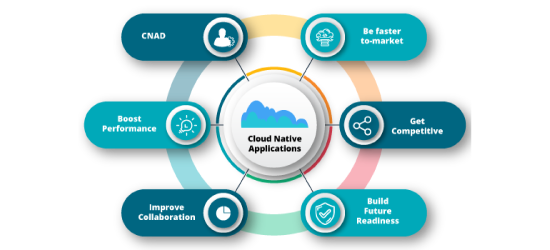
As enterprises move onwards and upwards in their digital transformation journey, the next natural stage of progress is cloud-native application development to meet changing customer-demands. Beyond developer efficiency, cloud native app development (CNAD) enables organizations to break down their monolithic applications into loosely coupled services and move them into the cloud. Container management, with its ability to deliver agile support at scale, continues to drive adoption of cloud-native architecture.
Focus Areas in Moving to CNAD
The journey to cloud-native application development demands a strategic plan for cloud-centric environments that helps ensure business continuity and achieve digital transformation objectives while enabling automation of routine business processes.
Plans should factor in the following:
- Reduce complexities stemming from legacy development processes. Organizations can achieve this by opting for low-code platforms if the organization is new or not fluent with APIs, containers, and microservices
- Quiz the Cloud Service Provider (CSP) on how the platform will support business-specific cloud-native objectives
- Adopt PaaS solutions to kick-start CNAD journeys
- Bridge gaps in automation and management, and achieve seamless workflows through use of templates
- Take an agile approach to infrastructure management and leverage the complete IaaC stack to strengthen your infrastructure management
Cloud-Native Application Development Best Practices
- Segregate monolithic applications into loosely coupled microservices.
- Build infrastructure & workflow automation
- Implement efficient CI/CD pipelines
- Store infrastructure as code (IaC) in a effective version control system
- Implement DevOps methods and processes
Accelerating Innovation with Cloud-Native Applications
Cloud native applications are by design scalable and flexible. Unlike monolithic applications, they comprise several independent microservices, which can be updated, improved, and replaced easily using an agile DevOps approach. I.e. Developers don’t need to rewrite individual microservices. They can simply update specific components while releasing new codes into production. This reduces the cost of building/modifying/updating legacy applications. It’s offers a creative environment, empowering innovative solutions that retain customers and attract new ones.
Advantage: CNAD
Eliminate Large-Scale Development
Leveraging containers on the cloud lets organizations modernize applications seamlessly, deploy them quickly and conduct on-the-go modernization. All in all, it helps organizations save significantly on resources and time expended in making improvements.
Boost Performance
As customer demands grow and evolve, there is growing pressure on DevOps teams to meeting these demands. A cloud-native strategy allows software developers to deliver performance improvements with agility.
Improve Collaboration
Performance optimization is a priority of all organizations. This can be efficiently achieved by integrating platforms and applications with open-source software. A cloud-native strategy enables organizations to collaborate with relevant applications as well as CSPs, resulting in improved functionalities and integrated features.
Be faster to-market
Cloud native app development is driven by flexibility and efficiency. This empowers them to add new features in real-time, while saving on operational expenses and scaling resources vis-à-vis demand dynamics.
Get Competitive
Cloud native app development allows organizations to integrate next-gen tech, such as blockchain, AL & ML to deliver a better and consistent customer experience. In the process improving their customer engagement and fulfilling their own competitive potential.
Build Future-Readiness
Among the many reasons organizations that have their workloads in traditional systems find it difficult to establish new architectures are: technical debt, management complexities, and high maintenance costs. Moving their traditional workloads to the cloud lets them simplify their IT environments and bring all the advantages of CNAD to bear in gaining a competitive advantage, cost effectively. Cloud native application development has enabled organizations to scale in a fail-fast mode. Containers has majorly contributed to achieving cloud-native computing visions by providing a flexible innovation catalyst.
Open-source platforms, too, are playing a critical role in accelerating movement of business and operations support systems to microservices-based cloud-native infrastructure. These platforms enable business and network automation, enable automated operations and deliver high value.
Conclusion
As the move towards cloud-native application development grows, it is increasingly imperative that organizations across industries plan to modernize their legacy applications for cloud-readiness and compatibility.







































